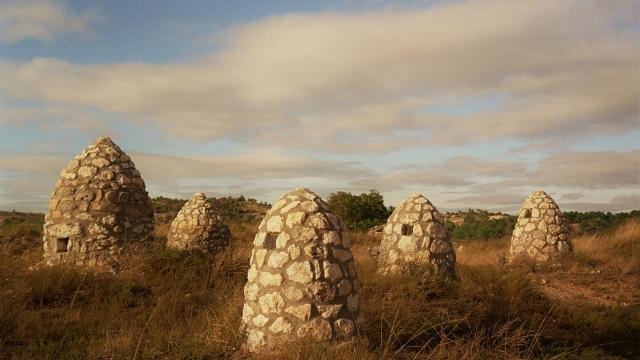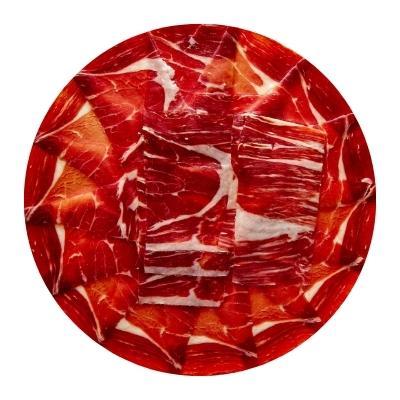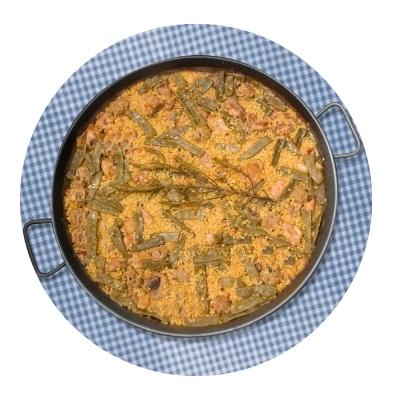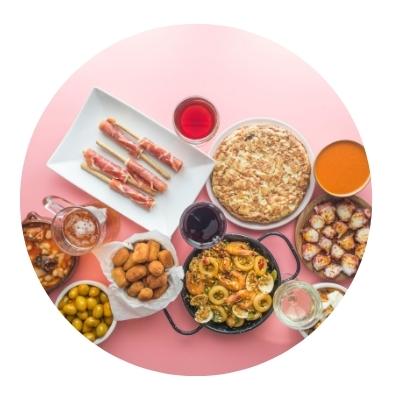The art of winemaking high above the Duero River

Our journey takes us to the Spanish wine region Ribera del Duero D.O., where we will visit the winery Cillar de Silos in Quintana del Pidio (Burgos). We will learn what makes wines of the Aragón García family truly outstanding, what we can expect from the 2020 Pandemic vintage and which red is a more than worthy wine pairing for the Christmas feasts on the approaching holidays. And, of course, for the numerous festive occasions that we will hopefully celebrate in 2021
In the North of Aranda del Duero, in the Spanish wine region Ribera del Duero D.O. [http://www.riberadelduero.es] (Burgos) at an altitude of just above 850 metres above sea level, lies the small village of Quintana del Pidio. The historic village counts today with only 150 inhabitants, looks back on a tradition of over 800 years in the cultivation of vines. It is a truly privileged area of the Duero due to the microclimate and the diverse soils, which are a guarantee for the best grapes and thus top terroir wines, such as those bottled by the Bodega Cillar de Silos and Dominio del Pidio. Both are prestigious brands of the Aragón García family.
In the 1970s, the back then grain farmer Amalio Aragón, who founded the renowned bodega with his children in 1994, acquired old vines from other farmers from Quintana del Pidio that he had heard about from hearsay. And planted them on his land. At first, he produced wine exclusively for the family's own consumption and for friends. It was his children, Roberto, Óscar and Amelia, who gave the viticulture project its shape and who started marketing the wines. Óscar Aragón is the chief oenologist and technical director, Roberto Aragón is the executive manager and, from her office in London, Amelia Aragón takes care of promotion and marketing.

The "River of Wines" of Iberia
The Duero river, known as Douro in Portugal, crosses the north of the Iberian Peninsula and, as the third longest river in Spain after the Tagus (port. Tejo) and the Ebro, is the lifeline of the Castile-León region. Before meandering through Portugal and finally flowing into the Atlantic at its estuary near Porto. Along its almost 900-kilometre-long course, world-famous and lesser-known wine-growing regions stretch out: besides Ribera del Duero D.O. and Rueda D.O. or Toro D.O. in Spain and, of course, Douro D.O.C. in Portugal, where not only the grapes of the vines for the port ripen on the steepest slopes. But also, for red, white and rosé wines.
"In Ribera del Duero we have a variety of micro-climates that are not really known and that allow the production of special and unique wines. Which embody the character of their environment. Unlike in Rioja [enlace a los Riojas de Colono], where you have the High Rioja, the Low Rioja and the Rioja of Álavas in the Basque Country, with their very specific characteristics," Óscar Aragón explains.
"The Torresilo is our standout wine at Cillar de Silos," he says: "Only the best grapes from the best plots we have are used for this wine." They come exclusively from old vines that are from 50 to over 100 years old and have survived the phylloxera plague. "Accordingly, the harvest quantity is low, a maximum of 2400-2800 kilos of grapes per hectare. But therefore, the higher is the quality of the grapes," Óscar Aragón emphasises. At this age, the vines practically take care of themselves, and the harvest is done only manually. The Aragón-Garcia-family have been following all the standards of organic farming and production, but they have not yet received the organic seal.
The Torresilo, made exclusively from Tempranillo, which Colono Gourmet offers as a 2017, a top vintage, is matured only in almost brand-new wooden barrels made of French oak. Depending on the vintage, this takes between 16 and 18 months in the barrel. "We work with four barrel makers, two of them from Burgundy and two from Bordeaux," says Roberto Aragón: "It's a very special wine, unbeatable I mean, in the price-quality ratio." And an ideal companion for festive occasions and dishes, like for the approaching Christmas feasts. Decanting and letting it breathe is essential so that this elegant, deep red wine can fully develop its aromas, ripe red fruits, some plum, nutmeg and liquorice with all its round tannins.
The soils on which the Aragón García family has its vines are highly diverse. "They have nothing in common with the Duero soils of the area around Peñafiel in Valladolid province," says oenologist Óscar Aragón: "That's because we have our vines at altitude and on slopes between valleys." Limestone soils, on the one hand, but also solid sub-layers of clay in the root zone, which serves as an ideal water reservoir for capturing the abundant rain- and snowfall, which are especially abundant in winter. "Our vines hardly ever suffer hydrological stress from extreme drought," he emphasises. Whereas, as in other historical wine-growing regions of Europe and worldwide, progressive climate change may mean that in extreme summers the possibility of drip irrigation must be considered, he adds. Compared to the Monastery’s records of past centuries, the grape harvest now usually begins at the end of September, rather than always around 12 October, Spain's national holidays and the religious holiday of Nuestra Señora del Pilar, as it used to be in the past.

Over 800 years of wine-growing tradition
As early as around 1190, Benedictine monks, at the Quinta del Pidio priory as part of the Monasterio de Santo Domingo de Silos – a true gem of Romanesque architecture – were already cultivating the local white grape Albillo Mayor, but of course also red Benedicto-grapes of that era. Genetic studies from 2012 finally proved the long-disputed origin of the Tempranillo grape, today the most widely cultivated in viticulture in Spain. Since the monks cultivated white and red grapes side by side from the 12th century onwards, it was the result of a spontaneous crossing of the two, Albillo Mayor and Benedicto, and was first mentioned in writing as "Tempranillo" already in the 13th century.
Furthermore, monastery chronicles report that at that time the monks were entitled to six litres of wine per head per day. More than 80,000 vines grew around Quintana del Pidio to meet what we would today consider a rather excessive demand. In the Middle Ages, wine was a substitute for water, which it often completely replaced or was mixed with it. Simply because of the danger of infection by germs and bacteria in water. And the monastery wine (colloquially called in Spanish "Ojo Gallo", literally "chicken's eye", synonymous for corns on one’s feet) made from red and white grapes did not reach the alcohol content of today's Duero wines. Monastic viticulture finally ended abruptly in the 19th century, when under the then finance minister and later prime minister Juan Álvarez Mendizábal, with the "Desamortización de Mendizábal" of 1835/36 (under Queen María Cristina de Borbón), many church estates and lands were transferred to state ownership. Among them, those in Quintana del Pidio.
So much for the history, that lives on today in the wines of Cillar de Silos, and not only in the vines. Aragón García family also successively acquired and restored and modernised the underground, walled wine cellars. The ideal place to store and age the wines. "In the cellars, the ‘cavas’, natural conditions prevail, constant temperatures between eleven and twelve degrees Celsius all year round and a humidity of approximately 78 percent. We therefore do not need any additional electrical energy, which immensely reduces the ecological footprint of our production," Roberto Aragón continues. The fact that several wine cellars have been joined together also ensures that a constant draught of air prevents mould growth here, which can damage corks, barrels and thus the wines. "This is unique in the Duero," he says.

Red and white, side by side
After Cillar de Silos, with 27 years of history, the Aragón García family has launched a second, new project for top wines: Dominio del Pidio, with a comparably small annual production of only 50,000 bottles. Among them is La Viña De Amalio, which is made from the aforementioned very old-aged Albillo Mayor vines acquired by father Amalio in the 1970s. "The production is small, but the project is enormous," Roberto Aragón points out: "We are buying up old cellars and vineyards from the 1920s, 30s and 40s, and planting old vines, white and red side by side on the same plot, just like the monks once did." One of the main objectives is to preserve the historic white grape Albillo Mayor and raise its status among wine lovers. "This grape variety has almost completely disappeared, and we use it for the three wines of Dominio del Pidio, of course in the white wine Cillar Blanco De Silos, the rosé wine Cillar Rosado de Silos, and the red La Viña De Amalio as a cuvée with Tempranillo", explains Óscar Aragón.
The rosé (50 % Albillo Mayor, 50 % Tempranillo) has always had its place in the family business, also because her father Amalio Aragón personally prefers it. Therefore, the first pressing of the grapes from the oldest vines is always used for it. All the wines from Dominio del Pidio are also not put into stainless steel tanks, but are matured in oak barrels or concrete tanks, both of which are porous. "In all aspects, we follow the historical principles of wine production," he continues.
"We have been making whites from Albillo Mayor for over 20 years, but it was only in 2019 that these wines received the D.O. Duero designation of origin," Roberto Aragón points out. He adds that this white cannot be compared to the well-known Spanish white wines, such as the fresh, flowery Verdejos from Rueda with tropical fruity aromas, or the Albariños (port. Alvarinho) from Galicia in Northwest Spain and Northern Portugal. "This grape is much more like the French ones," says Óscar Aragón. These white wines would gain with age, which is due to the respectable acidity - and their maturation, "always barrique and above their own lees".

"Above average, good wine year 2020"
In "year 1" of the coronavirus pandemic, it was possible to harvest the old vines manually, otherwise it would not have been possible anyway to use machinery on these plots. But due to a lack of manpower, many other plots of young vines between 20 and 40 years had to be harvested by machine for the first time. Economically, of course, the Aragón-Garcia-family noticed the immense slump in the gastronomy and hotel industry, because of the lockdown phases. As they have numerous important customers in the upper middle class and top-class gastronomy. On the other hand, private sales to households increased significantly, which however could not nearly amortise the loss, but "at least we did not lose the 2020 year", Roberto Aragón emphasises.
And what can we already say about the "2020 vintage"? It was not extremely hot, and not extremely dry, but the autumnal rains set in a little earlier. "Up until the summer, the year 2020 was climatologically excellent, the ripening process was practically on time," says Óscar Aragón: "Around the grape harvest, the temperatures dropped, and the first rains started. We were lucky, though, because we already started the grape harvest at the end of September." 2020 has been a year with a truly large harvest of grapes for this family of winemakers. And the quality of the grapes was also higher than in the last two years. "It was a bad year because of the pandemic, but definitely above average in terms of wine," both brothers agree. So hopefully in ten or twenty years, we will be able to open a bottle of “Torresilo 2020” and toast with a top wine to the fact that we all survived the pandemic year, both health-wise and economically. A wish I share with the Aragón García family and of course with all of you.
My next Iberian voyage will take me to one of my absolute favourite parts of the Peninsula: the Dehesas of Extremadura of Southwestern Spain. Where I will taste the best Ibérico hams and ask the producers about the secrets of what makes a top-quality Jamón “de bellota” (acorn-fed Iberian pigs). Until then, from the bottom of my heart, I wish you Felices Fiestas, at best with your families and loved ones, con dulces momentos, buen provecho y sobre todo, ¡salud!
SHARE:





